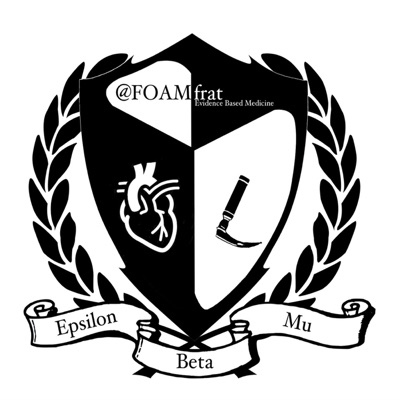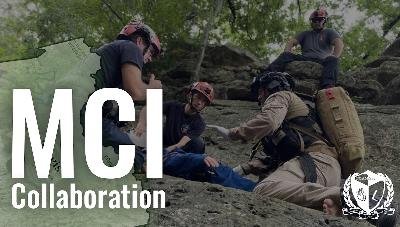Discover FOAMfrat Podcast
FOAMfrat Podcast

207 Episodes
Reverse
A little over a year ago, I made a short reel discussing ventilating a patient in a severe metabolic acidosis. In the video, I mentioned that minimal to no PEEP might be appropriate. Not because the patient doesn't need PEEP, but because the shortened cycle time at higher respiratory rates can unintentionally generate dynamic PEEP on its own. But what if it was intentional? What if the presence of a wider pressure when the ventilator switches into exhalation would cause the air to exit more rapidly? In this podcast, I discuss my thought process with respiratory therapist extraordinare, Melody Bishop @melodybishop_rt. She helps surface some definitions and distinctions to terms like air-trapping, Set PEEP, & auto-PEEP while we discuss ventilation strategies in metabolic acidosis. The blog below was what I had sent her before the podcast to get all my thoughts & illustrations down in writing. As always, please follow your local guidelines, and I hope you enjoy listening to the conversation.
Pelvic binders have long been considered a standard intervention in the management of suspected pelvic fractures in the prehospital setting. However, recent guidance from the National Association of EMS Physicians (NAEMSP) challenges some of the long-standing assumptions surrounding their use. In a recent FOAMfrat podcast episode, I spoke with Dr. John Lyng, editor-in-chief of the NAEMSP Trauma Compendium, to explore the evidence and rationale behind their newly released position statement on pelvic fracture management.
In this episode, Tyler sits down with Hanna Thompson to discuss a critical yet often overlooked topic in EMS—eating disorders. Drawing from personal experience and clinical insight, they explore how these conditions present both medically and behaviorally, especially in prehospital and interfacility transport settings. They break down the subtle physical signs that EMS providers can look for—such as Russell's sign, lanugo, unexplained bradycardia, and electrolyte disturbances—and emphasize the importance of sensitive history taking. The conversation also dives into the dangers of refeeding syndrome, slow correction strategies, fluid choice, and the clinical significance of thiamine, magnesium, and phosphate replacement. What You'll Learn: How eating disorders can manifest in EMS calls Why you may be treating the consequences, not the disorder itself Red flags like bradycardia, lanugo, and Russell's sign How to handle refeeding syndrome safely Why dextrose, fluids, and electrolyte replacement should be approached cautiously The connection between electrolyte shifts and seizures or arrhythmias Key Takeaway: Patients with eating disorders are medically and psychologically fragile. In EMS, we often encounter them through the effects of the disorder—not the diagnosis itself. Recognizing subtle clues and avoiding aggressive interventions could save a life. Resources Mentioned: Hannah's blog on EMS considerations in eating disorders Data on post-COVID spikes in eating disorder incidence Guidelines for electrolyte correction and refeeding syndrome Disclaimer: This podcast is for educational purposes only and not a substitute for clinical protocols or medical direction. Always consult your agency's guidelines and medical control.
In this episode, Tyler Christifulli sits down with cardiac perfusionist Brian Cress to dig into the physiology of coronary perfusion, the mechanics of the intra-aortic balloon pump (IABP), and the clinical finesse of diastolic augmentation. Whether you're just starting to encounter balloon pumps or want to sharpen your transport strategy, this discussion is packed with visual metaphors, waveform analysis, and real-world pearls.
In this conversation, Dr. Peter Weimersheimer discusses various techniques and tips for performing cardiac ultrasound in emergency medicine. He emphasizes the importance of understanding probe movements such as sliding, fanning, and rocking to optimize cardiac views. The discussion also covers troubleshooting common challenges in cardiac imaging, the critical role of gel in obtaining clear images, and the transition between different cardiac views. Dr. Weimersheimer emphasizes the importance of identifying cardiac pathologies through ultrasound and shares techniques for obtaining the apical four-chamber view. The conversation concludes with insights into the impact of ultrasound on patient care and decision-making in emergency situations. In this conversation, Dr. Peter Weimersheimer shares his expertise on cardiac ultrasound techniques, with a focus on the apical four-chamber view and the importance of understanding ventricular shape and function. He discusses practical tips for navigating ultrasound views in critical situations, optimizing imaging techniques, and utilizing patient physiology to enhance imaging quality. The conversation also covers the interpretation of right ventricular size in cardiac arrest and differentiating between the inferior vena cava (IVC) and aorta during ultrasound imaging.
Stroke assessment tools like BEFAST are crucial for swiftly identifying symptoms and expediting treatment. However, language barriers can hinder prompt care for non-English speakers, particularly in the Hispanic community. Developed through a collaborative effort, AHORA adapts the traditional stroke assessment to be culturally and linguistically appropriate for the Spanish-speaking population. Designing Ahora The need for a specific tool became apparent when traditional tools like BEFAST were found to be ineffective for those who did not speak English. After discarding the complex "Rapido," Banerjee's team crafted Ahora, including Marcia Wilson, MD, and Remley Crowe, PhD. This tool was made to mirror BEFAST but is simplified for practical use within the Spanish-speaking population.
Does medicine have dangerous side effects for women? Are the "normal" values we have set for diagnostics possibly endangering specific populations? In this episode of the FOAMfrat podcast, Tyler sits down with Dr.Alyson McGregor, emergency physician and author of Sex Matters, and Tim Redding, EMS educator and lecturer, to discuss the discrepancies in medical testing, diagnosis, and treatment between male and female patients. Dr. McGregor shares her journey of discovering gender bias in medicine, particularly how women's symptoms are often dismissed or mislabeled as psychiatric in nature. The discussion explores how male-centric research has shaped clinical guidelines, leading to underdiagnosis and undertreatment of women across a wide range of conditions—from heart attacks to strokes and even pain management.
In this episode of the FOAMfrat podcast, join as we discuss mass casualty management with Chief Robert Luckritz of Austin Travis County EMS and Justin Soulier from Travis County Star Flight. Explore the strategies and challenges in mass casualty responses in one of the fastest-growing urban areas in the U.S.
Join Rommie Duckworth and FOAMfrat as we discuss the mental framing and big-picture thought process behind the first five minutes of any mass casualty incident (MCI). Rommie Duckworth, a fire captain and shift commander, is a wealth of knowledge on this topic and speaks globally to prepare emergency responders for these events.
In this episode, Alec Wilcox & I discuss ECPR eligibility & preparation. ECPR, or extracorporeal cardiopulmonary resuscitation, involves taking a patient in cardiac arrest, sucking blood from their venous system, oxygenating it externally, and then pumping it back into their arterial system. This procedure helps maintain blood circulation and oxygen delivery during cardiac arrest, serving as a bridge to further therapy.
The integration of point-of-care ultrasound (POCUS) is transforming emergency medical services (EMS) by enhancing diagnostic capabilities and improving accuracy in answering important clinical questions. Recently, I had the opportunity to discuss this topic extensively with Allen Wolfe, the Senior Director of Education at Life Link III. A significant challenge in incorporating ultrasound technology within EMS has been overcoming initial barriers to adoption. Many programs, burdened by cost concerns and technological intimidation, have historically relegated ultrasound units to the back shelves. However, as Allen outlined, strategic changes in accessibility and training can dramatically alter this landscape.
In this episode, Dr Banerjee and I discuss a new traumatic brain injury (TBI) protocol his department is trialing for pediatric patients with moderate to severe TBI in collaboration with Arnold Palmer Hospital. This protocol involves administering Keppra and 3% saline in the pre-hospital setting.
Matt Hoffman is the editor-in-chief of PulmCCM, a blog that frequently updates its readers on evidence and best practices in critical care medicine. I have always wondered how our work in the field affects a patient's care downstream. Do pulmonologists ever sigh to themselves and think, "God, I wish paramedics would just start/stop doing ____________?" It turns out that this is not the case, but the discussion was super interesting, and I thank Dr. Hoffman for coming to the show.
In this episode of FOAMfrat, Tyler speaks with paramedic Kyle Rice to discuss a deeply personal and eye-opening experience—rolling his ambulance after running a red light. Kyle shares the lessons he learned about complacency, crew resource management, and the often-overlooked dangers of driving with lights and sirens. Together, they explore how EMS providers can stay vigilant behind the wheel, adopt safer driving practices, and shift their mindset when responding to emergencies. If you're an EMS provider, this episode is a must-listen for understanding the real-life risks of complacency and how to prevent accidents.
In this episode, I sit down with Dr. Jeffrey Jarvis, author of a fascinating paper on the impact of lights and siren (L&S) use in EMS responses. If you're like most of us, when you hear those blaring sirens and see flashing lights, you think, "Wow, someone's really in trouble!" But the truth, according to Dr. Jarvis' study, might surprise you.
In this podcast, we discuss the nuances and strategy of the T1 ventilator with RRT, Joe Hylton. Whether you're a paramedic or a healthcare professional involved in critical care transport, understanding the nuances of this advanced ventilator is essential to safe and effective patient transport. We break down the pressure-controlled ventilation with volume adaptive options and offer practical guidance on managing obstructive lung conditions like asthma during transport. Plus, we cover essential troubleshooting techniques to help you address common issues when things don't go as planned.
Thoracic dissections are surgical emergencies that require precise temporizing measures until surgery can be performed. In this session, participants will gain critical knowledge on recognizing key symptoms such as ripping back pain and unequal pulses, indicative of thoracic dissections. The discussion will focus on anti-impulse therapy, emphasizing using beta-blockers like esmolol and calcium channel blockers like nicardipine to control blood pressure and prevent further damage. Pain management strategies and the selective use of nitroprusside will also be explored. The class will address the unique challenges of managing blood pressure in prehospital settings, stressing the importance of a well-prepared plan.
In this conversation, Tyler and Dr. Cynthia Griffin discuss the finger thoracostomy procedure. They cover topics such as when to choose finger thoracostomy over needle decompression, the equipment needed for the procedure, the technique for performing the procedure, and potential complications and tips for success. They also touch on the use of chest tubes and the management of tension physiology. Overall, the conversation provides a comprehensive overview of the finger thoracostomy procedure.
Alaina Martini, a flight nurse at Allegheny Life Flight, shares her expertise on transporting patients with external ventricular drains (EVDs). She explains the indications for EVD insertion, such as aneurysmal subarachnoid hemorrhage and obstructive hydrocephalus. Alaina discusses the importance of assessing the color and texture of the cerebrospinal fluid (CSF) to detect changes and potential rebleeding. She also explains the process of inserting the EVD and how it is guided by CT scans to avoid damaging important brain tissue. Alaina emphasizes the need to know if the aneurysm is secure before adjusting the EVD drain level, as opening it too low can increase the risk of rebleeding. She also discusses the use of hypertonic saline and osmotic therapy to manage increased intracranial pressure. Tyler and Alaina discuss various aspects of managing patients with external ventricular drains (EVDs) during transport in this conversation. They cover topics such as the clamping of EVDs, positioning the patient's head, troubleshooting common issues, and securing the EVD during transport. Alaina provides insights and recommendations based on her experience as a neurocritical care nurse.
Dr. John Aho discusses needle decompression and the procedure's indications, techniques, and potential pitfalls. He emphasizes the importance of high clinical suspicion and the limitations of external signs in diagnosing tension pneumothorax. The conversation also covers the choice of needle insertion sites, the use of ultrasound, and the need for proper training and practice. Dr. Aho provides insights into the anatomical considerations and common mistakes made during needle decompression. He also explores the possibility of instant feedback to confirm successful decompression. The conversation discusses the problem of needle decompression failure rates and the need for a reliable indicator of successful decompression. The guest introduced the Cap-No-Spot, a device that uses colorimetric indicator paper to detect CO2 and determine if a needle decompression procedure was successful. The device has been shown to have higher sensitivity and specificity than human judgment. The conversation also touches on the importance of proper training and the device's potential applications beyond pneumothorax detection.












Hey guys, I live in the mountains of East TN. A "holler" is a hollow. it's a geographical feature, typically between 2 mountains, where it's like a small valley, but not really the same
I love the FOAMfrat podcast! You do a great job of making advanced concepts understandable. As a ground medic hoping to transition to flight in the near future, I really appreciate all the time that is put into making each and every episode.